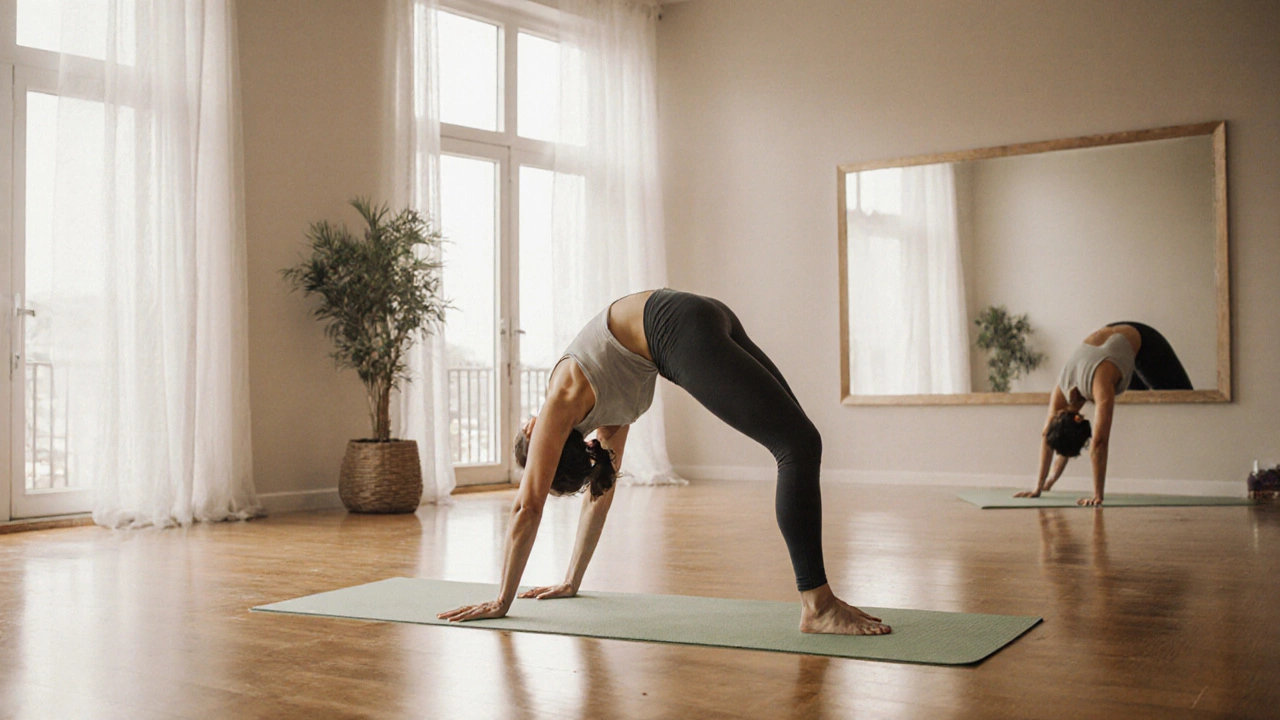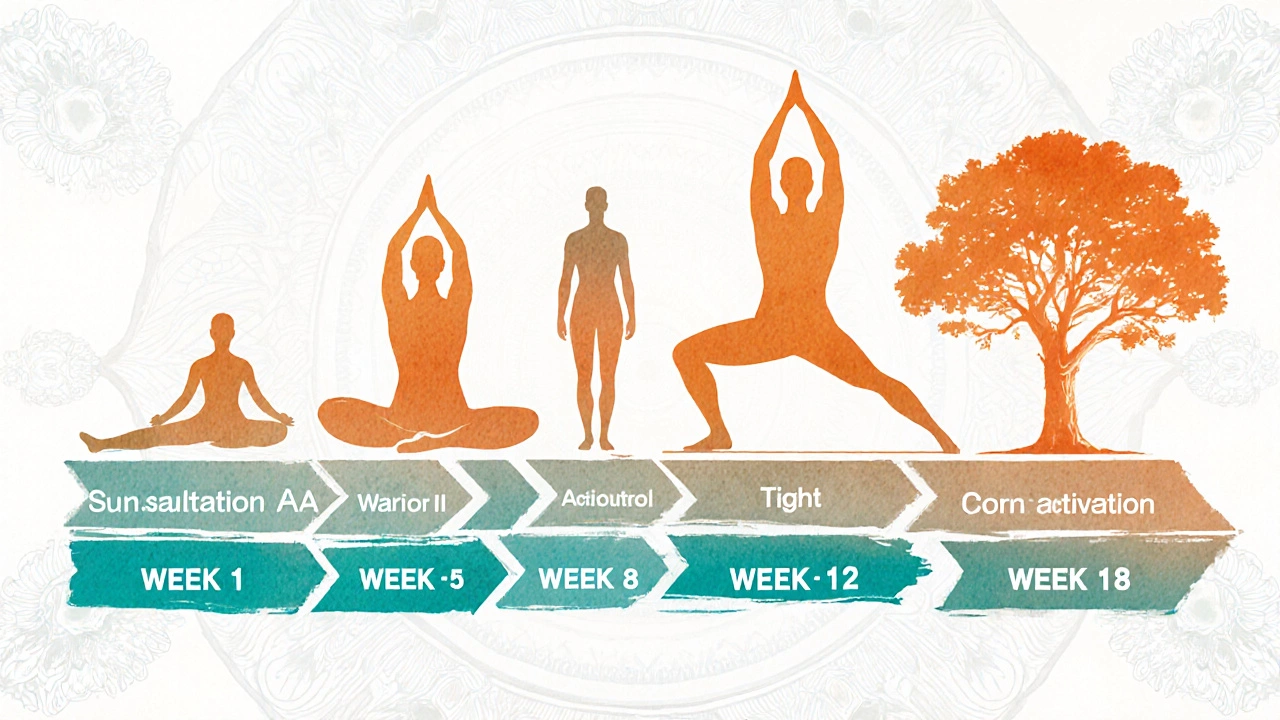
Yoga Transformation Timeline Calculator
Estimate when you'll see physical changes from yoga based on your practice habits.
Your Transformation Timeline
Quick Takeaways
- Most beginners notice increased flexibility within 2‑4 weeks.
- Noticeable strength and core tone appear after 6‑8 weeks of consistent practice.
- Improved posture and reduced stress can show up in as little as 1‑2 weeks.
- Frequency (3‑5 sessions per week) and style (Vinyasa, Power Yoga) speed up results.
- Combining yoga with proper nutrition, sleep, and occasional strength work maximizes transformation.
People often wonder, "How fast will yoga change my body?" The answer isn’t a single number-it depends on what you’re measuring and how you practice. Below you’ll find a clear timeline for the most common physical changes, the key factors that push the clock forward, and a realistic routine you can start today.
Yoga is a mind‑body discipline that mixes postures (asanas), breath work (pranayama), and meditation. By moving joints through full ranges, engaging muscles under load, and linking breath to motion, yoga triggers the same physiological pathways that traditional strength or cardio workouts do-only with a softer, more joint‑friendly approach.
What Your Body Is Doing When You Flow
Each yoga session creates a cascade of adaptations:
- Flexibility increases as connective tissue (collagen) remodels under repeated stretch. The more often you hold a pose, the longer the fibers become, leading to a wider range of motion.
- Strength develops because you’re supporting your own weight in multiple planes. Even a gentle Warrior pose forces the quadriceps, glutes, and stabilizer muscles to fire.
- Core muscles receive constant engagement to maintain balance and alignment, sharpening the abdominal wall and lower‑back support.
- Balance improves as the vestibular system and proprioceptors are trained, making everyday tasks feel steadier.
- Heart rate stays in a mild aerobic zone, which nudges metabolism upward, especially when you practice dynamic flows.
- Stress hormones (cortisol) drop, while calming neurotransmitters (GABA, serotonin) rise, producing a measurable stress reduction effect.
Typical Timeline of Visible Changes
If you’re chasing a yoga body transformation, here’s a realistic week‑by‑week roadmap:
- Week 1‑2: You’ll likely feel looser. Stretch receptors fire, giving a sensation of increased flexibility. Posture may improve as you learn to engage the spine.
- Week 3‑4: Consistent practice (3‑5 sessions) begins to tone superficial muscles. The calves, hamstrings, and shoulders look slightly more defined, especially after Vinyasa‑style flows.
- Week 5‑8: Core endurance builds. Plank‑like poses and boat pose create visible tightness in the abdomen. Many report a flatter mid‑section and reduced lower‑back ache.
- Week 9‑12: You’ll notice more substantial changes in body composition -fat loss paired with lean muscle gain. A combination of calorie burn from active flows and the hormonal benefits of stress reduction accelerates this shift.
- Month 4‑6: Long‑term benefits lock in. Joint health improves, balance is sharp, and everyday movements feel easier. At this stage, many say they look “leaner” even if the scale hasn’t moved dramatically.

Factors That Speed Up or Slow Down Results
Not all yoga journeys are identical. Pay attention to these variables:
- Frequency & consistency: Practicing at least three times a week creates the stimulus‑recovery loop needed for adaptation.
- Style intensity: Power Yoga, Ashtanga, or Vinyasa keep the heart rate up (120‑150bpm) and burn more calories than gentle Hatha or restorative sessions.
- Session length: 45‑60 minutes provides enough time to warm up, flow, and cool down, maximizing muscle fatigue and recovery.
- Age & baseline fitness: Younger bodies recover quicker, but even seniors see measurable gains if they respect their limits.
- Nutrition: Sufficient protein (0.8‑1g perkg body weight) supports muscle repair; balanced carbs fuel longer flows.
- Sleep: 7‑9 hours nightly boosts growth hormone, crucial for tissue remodeling.
- Stress level: High cortisol can blunt muscle gains; incorporating meditation helps keep hormones in check.
Sample 4‑Week Plan for Faster Physical Change
This schedule assumes you have a basic familiarity with core poses. Adjust intensity by adding more repetitions or holding each pose longer.
- Monday - Power Flow (45min): Sun Salutation A ×5, WarriorII → Reverse Warrior (3min each side), Chair Pose, Side Plank, finishing with a 5‑minute guided breath.
- Wednesday - Strength‑Focused Yoga (60min): Warm‑up with Cat‑Cow, then a circuit of Chaturanga, Boat Pose, Dolphin Pose, Bridge, and core twists. End with a 10‑minute supine stretch.
- Friday - Vinyasa Cardio (40min): Fast‑paced Sun Salutations, high‑knee flows, and rapid transitions between lunges. Goal: keep heart rate in the aerobic zone.
- Saturday - Mobility & Recovery (30min): Gentle Hatha, emphasis on hip openers (Pigeon, Happy Baby) and a 5‑minute body scan meditation.
Repeat the same weekly pattern for four weeks, then swap in new variations (e.g., crow pose or half‑moon) to keep the muscles guessing.
Common Pitfalls and How to Avoid Them
- Skipping the cool‑down: Ending abruptly can cause stiffness. Always flow into forward folds or savasana for 5‑10 minutes.
- Holding poses for too long early on: Over‑stretching can lead to joint pain. Begin with 20‑30seconds per pose, then gradually increase.
- Relying on “feel‑good” sessions only: Consistency beats occasional marathon sessions. Schedule yoga like any other workout.
- Neglecting strength training: Yoga builds functional strength but adding 1‑2 days of body‑weight or light‑weight work speeds up muscle hypertrophy.
- Ignoring breath: Breath is the conduit for oxygen delivery. Practice “Ujjayi” or “Box breathing” to sustain intensity.

Yoga vs. Other Workouts: Quick Comparison
| Attribute | Yoga (Vinyasa/Power) | Steady‑State Cardio | Strength Training |
|---|---|---|---|
| Primary benefit | Flexibility + functional strength | Cardiovascular endurance | Muscle hypertrophy |
| Typical calorie burn (30min) | 200‑300kcal | 250‑350kcal | 150‑250kcal |
| Impact on joints | Low‑to‑moderate (joint‑friendly) | Low‑to‑moderate (depends on impact) | Medium‑to‑high (load‑bearing) |
| Time to see flexibility gains | 2‑4weeks | Not a focus | Not a focus |
| Time to notice strength gains | 6‑8weeks | Variable (depends on intensity) | 4‑6weeks |
Putting It All Together
When you line up your goals-whether it’s a tighter mid‑section, better posture, or lower stress-yoga can deliver measurable change in a surprisingly short window if you respect the variables that drive adaptation. Pair consistent flows with proper nutrition, adequate sleep, and occasional strength work, and you’ll likely notice the first physical shift within a month, with more dramatic transformation by the three‑month mark.
Frequently Asked Questions
How many yoga sessions per week are needed to see results?
Three to five sessions of 45‑60 minutes each strike a good balance between stimulus and recovery. Fewer sessions may still improve flexibility, but strength and body‑composition changes typically require at least three weekly practices.
Can yoga replace weight‑lifting for muscle gain?
Yoga builds functional strength and improves muscle endurance, but it doesn’t produce the same hypertrophy as heavy resistance training. For maximal muscle size, combine yoga with 1‑2 days of traditional weight‑lifting.
Will I lose weight faster with yoga than with cardio?
Weight loss hinges on calorie balance. A vigorous Vinyasa class can burn comparable calories to a moderate jog, but yoga’s added benefits-stress reduction and muscle tone-help maintain the deficit long‑term. Pair yoga with mindful eating for best results.
Is it safe to practice yoga every day?
Yes, provided you vary intensity. Alternate vigorous Vinyasa days with gentle Hatha or restorative sessions to let muscles recover while still gaining flexibility and relaxation benefits.
How does yoga affect metabolism?
Dynamic flows raise heart rate into a mild aerobic zone, which boosts post‑exercise oxygen consumption (EPOC). Over weeks, this elevated metabolic rate helps the body burn slightly more calories even at rest.
